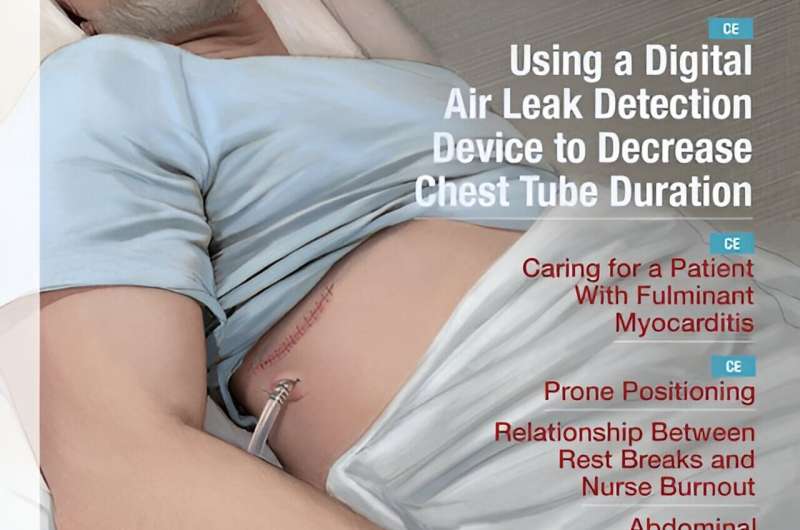This article has been reviewed according to Science X's editorial process and policies. Editors have highlighted the following attributes while ensuring the content's credibility:
fact-checked
proofread
Improved air leak detection reduces chest tube duration: Study

An initiative at a Texas hospital contributed to reductions in chest tube duration, hospital length of stay and readmissions for patients with lung cancer who had a pulmonary lobectomy, according to new research published in Critical Care Nurse.
A multidisciplinary team from the department of thoracic and cardiovascular surgery at University of Texas MD Anderson Cancer Center, Houston, undertook the initiative to determine if a digital air leak detection device could better pinpoint when a patient no longer needs a chest tube due to an air leak after lung cancer surgery.
The article, titled "Use of a Digital Air Leak Detection Device to Decrease Chest Tube Duration," describes how the project helped standardize management of air leaks, improve patient safety and ensure consistent care and outcomes.
Co-author Carla Patel, DNP, APRN, ACNP-BC, is an advanced practice nurse in the unit where these patients typically receive care.
"We identified short-term, long-term and impact goals for the project, with an eye toward sustainability and embedding it into routine care," she said. "We took a conservative approach with a low threshold for airflow to avoid complications and further build trust in the new process."
Members of the thoracic surgery team assess patients' chest tubes for postoperative air leaks, and quantifying the results with analog devices may vary between clinicians. Identifying when air leak cessation occurs is a critical step toward chest tube removal, which has a direct impact on the patient's hospital length of stay.
When new guidelines issued by the Enhanced Recovery After Surgery Society and the European Society of Thoracic Surgeons in 2018 recommended use of a digital device for air leak detection as part of chest drain management, the surgical group took steps to methodically incorporate such devices into patient care.
The project began with an extensive literature review, particularly of studies with randomized controlled trials and meta-analyses. This prior research supported the decision to move forward with the proposed project.
In addition, the evidence indicated that use of a digital air leak detection device in patients who have undergone pulmonary lobectomy can lead to quicker recognition of air leak cessation, earlier chest tube removal, a decrease in hospital length of stay and lower overall costs.
With the potential benefits supported by evidence, the research team developed a pilot project to attempt to replicate the results, using a single digital device and a small group of patients who would benefit the most from the resource.
Every patient who undergoes a lobectomy may not require a digital device, so the final patient population consisted of 25 admitted patients who had an initial pulmonary lobectomy and still had an air leak on postoperative day three. They were admitted over a span of 10 months, providing a good representation of the practice.
When outcomes from the study population were compared with the historical data of 259 patients admitted over a two-year period prior to implementation (Jan. 1, 2018, through Dec. 31, 2019), the research team found significant differences:
- 56% of patients in the digital device group had their chest tubes removed a day sooner than those in the traditional device group.
- 72%t of patients in the digital device group were discharged a day earlier than those in the traditional device group.
- 92% of eligible patients had their chest tubes removed when the criteria was initially met.
- Readmissions for the digital device group were zero, while 10 readmissions were recorded in the traditional device group.
Based on the project findings, the team created a chest tube management algorithm to standardize use of the digital air leak device for this patient population. Ongoing education about the algorithm was integrated into orientation for new team members, and four additional digital devices were purchased.
More information: Carla Patel et al, Use of a Digital Air Leak Detection Device to Decrease Chest Tube Duration, Critical Care Nurse (2023). DOI: 10.4037/ccn2023951



















